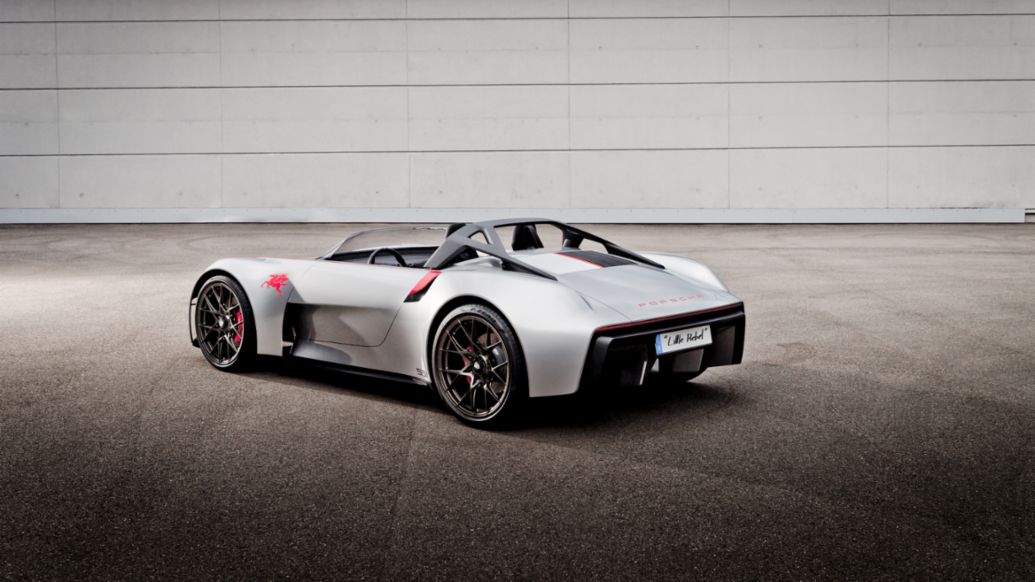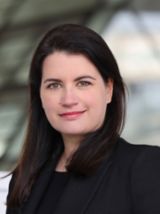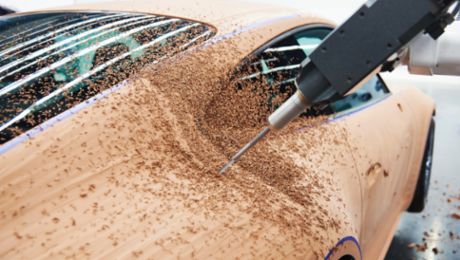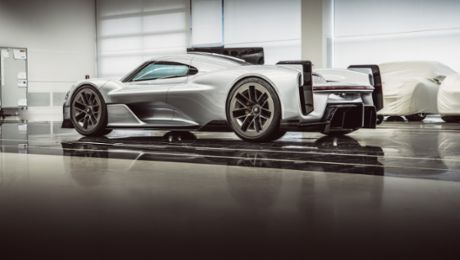Twenty years sounds like a harmonious relationship. You are only the fourth head of design in the history of the brand – after F.A. Porsche, Anatole Lapine and Harm Lagaaij. How do you explain this continuity in the design discipline at Porsche?
Mauer: Continuity is an important aspect of the company philosophy at Porsche. As a luxury brand, Porsche is not about constantly inventing new things, but rather continuously refining things that are already good. Consistency is part of a strong brand identity. It seems to have been a good fit between me personally and the company – otherwise Dr. Wolfgang Porsche or Ferdinand Piëch would have quickly pulled the plug on me right at the outset (laughs).
Porsche is one of the few big automotive brands that is led by a family. Does that influence the work of a designer?
Mauer: It is certainly an extraordinary situation to stand before a Chairman of the Supervisory Board who bears the name Porsche and explain why you believe that a new model is still a real Porsche despite some rather significant visual changes. That took some getting used to. At the same time, companies with a long history tend to think long-term; they don’t jump on every bandwagon. That is also reflected in Porsche’s values and the evolutionary design culture – and ultimately fosters strong, timeless design.
„Continuity is an important aspect of Porsche's corporate philosophy.“ Michael Mauer
Despite all the continuity, you have established a new design culture at Porsche over the last 20 years. What have you done differently from your predecessors?
Mauer: When I started at Porsche, there were only three model lines in production – the 911, the Boxster and the Cayenne. The designers sat together in the courtyard and waxed philosophical about lines, and deadlines were regarded as rough guidelines. They enjoyed the freedom of artistic creativity. I had learned the strict process chains of industrial firms at Mercedes-Benz, Saab and GM, and with that knowledge in hand I began to reorganise the design unit at Porsche. Instead of assigning lead designers for individual model lines, I divided the work process into exterior and interior design, colour and trim units and put the most competent designers with right mindset for the respective specialisation in those positions. That paid off in terms of design quality. Finally, the User Experience, or Driver Experience as we call it at Porsche, was spun out as the digital interfaces between the car and the human have become ever more important.
As Vice President Style Porsche, you pull all the strings in this complex process. But at the same time you have to create the space for creativity. How do you manage that?
Mauer: Particularly in the early phases of a project, I want and need to have a very restrained posture, keep the briefing as open and possible and not give a sense of my own ideas. Otherwise I would completely stifle the creativity of my team and all of the proposals would look the same. You have to bear in mind that the likelihood of a designer’s design coming out on top in the internal competition and then actually making it to the road is really quite small. Even so, I want to motivate my team to go at it full-bore and believe in their ideas. My job is then to narrow it down to the truly good, sustainable ideas and sell them internally.
So as the head of design, your job is actually as an advocate of ideas who has to sell other departments and the Executive Board on new approaches?
Mauer: Let’s put it this way: in my next life I’ll study political science and rhetoric – an evening class would suffice for the drawing (laughs). But in all seriousness, presenting good ideas with compelling arguments, making the logic behind it understandable and getting all the decision-makers on board is definitely one of my most important tasks.
Through digitalisation, and most recently artificial intelligence, the design process has changed radically. But at Porsche you still draw and tinker with clay models. Why is that?
Mauer: Digitalisation has radically accelerated our processes. In the past, it could sometimes take weeks to revise a model. Today, it can be re-rendered overnight and you’ll have the result the next morning. Using AI, a data modeller can create astonishingly realistic visualisations in minutes. But when it comes to the quality of surface finishes, physical scale models are still indispensable. You can tell by looking at a car if it was exclusively developed on a computer, or whether a designer – as with the Porsche 911 – gave it the final finishing touches by hand. A trained designer in front of a 1:1-scale model in the room intuitively notices things that they wouldn’t necessarily have noticed in a 3D model. Moreover, craftsmanship has a very special significance for the identity and storytelling of a luxury brand. The human factor is and always will be a selling point and quality marker, particularly in the age of artificial intelligence.
"The human factor is and remains a quality feature." Michael Mauer
But at the same time the design process has accelerated dramatically. Can human intelligence even keep up with it?
Mauer: That’s true. But whether I, as a designer, draw up a car with a pencil and paper or on a tablet, the intellectual activity remains the same. It used to take three days for a model to be milled. Today, that can be done in an hour. But the creative process can’t be sped up infinitely. You still have to give ideas and designs the space to unfold their effect. And give designers the time to think things over and critically scrutinise their work. Even the happy accidents that happen during testing and tinkering are part of that. They ultimately increase the design quality.

In the past, automotive designers were mainly regarded as exalted stylists and artists who lend the engineers’ developments a beautiful shell. In recent decades, however, and influenced by the triumph of “design thinking” in Silicon Valley, a more holistic definition of the designer gained a foothold. What do you think is the role of a designer in the company today and in the future?
Mauer: In the past, automotive design was mainly packaging work – we came into play when the basic structure of a car was already defined as a blueprint. But good design thrives on perfect proportions. And they are already defined in the packaging. That is why I was committed to involving the design department in the conception of new products from the outset. At the same time, designers have a holistic view of things: they define the brand identity and holistic brand perception with their work – and are therefore strategically of great importance for the further development of the customer experience. The design principles and brand values that we have defined with our history in mind and with which we work on a daily basis can also offer orientation and added value to other areas of the company. Especially when it comes to breaking new ground. They guide us in the right direction like a compass – but do not limit our freedom of movement like a navigation system that uses calculations to determine the exact route.
"A successful designer is good with people." Michael Mauer
The Porsche design department in Weissach is already working right next door to chassis development, while prototypes are putting in their laps on the test track right outside the window. Is this spatial proximity typical of Porsche?
Mauer: Absolutely! The biggest challenge as we grow is to maintain our spirit – and the permeability of the studios in Weissach and the collaborations of the departments is an incredible advantage in that. As designers, we have a sort of liaison function in the company. You always have to be in dialogue. With the strategists, you discuss market opportunities, with salespeople talk about selling points, with technicians it’s about the limits of what’s possible, with colleagues from quality assurance it’s about feasibility aspects. A product specialist will tell you that although your idea looks good, the sheet metal will never bend the way you want it to – until you convince them otherwise. A successful designer gets on well with people, working together with them instead of against them. I sometimes wish this knowledge would be imparted at the universities. Most decisions in the design process are not made in the meeting room, but in conversations in the hallway or at the coffee machine. That’s the spirit in Weissach.
When you started with Porsche 20 years ago, one of your tasks was also the further development of the Porsche 911 – an established design icon. Were you looking forward to that undertaking? Or was that huge responsibility more of a burden?
Mauer: As a designer, evolving the Porsche 911 in an authentic way is both a huge privilege and a huge challenge. So it’s all the more gratifying if you manage to guide it into the future in an authentic way. At the same time, there are many projects at Porsche where you can start with a blank sheet of paper – show cars or super sports cars such as the 918 and the Mission X. This range of possibilities is only available at Porsche. Personally, however, it gives me great pleasure to help shape not only the appearance of individual models, but indeed the direction of the brand.

Which three models that you have worked on in the last 20 years are particularly close to your heart?
Mauer: First of all I would mention the Taycan. There were major reservations within the community: after the change from the air-cooled to the water-cooled boxer engine, the all-electric drive was ultimately the second major paradigm shift of our era. Sales might have been more inclined toward an SUV – but I felt that the first all-electric Porsche had to be a real sports car. And the package has remained extremely close to the concept car. The second car is the first-series Macan. Here, too, we broke new ground and worked with a platform from the Group. I’m still delighted with the simple elegance of the design. And then you have the Porsche 997 – the first 911 where I was able to be fully involved. The proportions, the narrow tail lights – I am still pleased that this was the design that carried the day.
As an outside observer, you see a new Porsche for the first time at its unveiling. As a designer, you have a completely different perspective: you know the proposals against which this one prevailed. You know the genesis of every detail. Are there also moments when you look at a car and regret something?
Mauer: For me, the latest innovations are almost classic cars (laughs). We’ve often been working on them for years by that point. So I have a certain distance. But of course you are aware of the history of its creation – and certainly I have not always prevailed with my personal preferences. But that’s part of the experience.
One contentious issue at the moment is the interface design. Does a Porsche really need a huge screen?
Mauer: The design of the user interface and the user experience is very important in my opinion. This is the point of contact between the human and the machine. And here, too, the identity of the Porsche brand should be front and centre. At the same time, it’s important not just to look at competitors and measure their screens, but to go our own way. A Porsche is a sports car – the driver’s focus is on the road. With larger, more comfortable model ranges such as the Cayenne, the theme of entertainment naturally plays a greater role than in a GT3 RS, so there the screen size can keep pace with the general customer needs that the Sales department conveys to us. At the same time, the need for individual large screens is less and less pronounced – information is projected onto the windscreen and you interact with the car via voice control. I’m not worried about a screen on wheels.
"I'm not afraid of the screen on wheels." Michael Mauer
Notwithstanding your confidentiality obligations – what will the Porsche of the future look like?
Mauer: They will still be identifiable as a Porsche at first glance. As a new Porsche. There will always be a stringent, rather evolutionary design philosophy that creates a recognition value through the light signature, for example. At the same time, there are really no limits on our creativity in the further development of the brand and product identity. We demonstrated that with Mission X. We will continue to grow as a brand, so there will be new models in categories in which we are not yet established. At the same time, of course, we will not forget our heritage, but stick to our design principles and remain true to ourselves. Even visionary luxury brands such as Louis Vuitton or Bottega Veneta always keep their classics in the line-up while they explore new areas creatively. In the end, established classics and new developments have to strike a balance. For every new comfortable SUV in the portfolio, I have to build a radical sports car as well.

If you could design your very own dream car like Ferry Porsche did – and the authorities would turn a blind eye in honour of your anniversary: What car would you build?
Mauer: That would be a road version of the Porsche Vision Spyder 551, which we have shown in the book “Porsche Unseen”. A spiritual successor to the Porsche 550 – compact, lightweight, purist, agile. But actually I have already found my dream car: I’ve been driving a Boxster Spyder RS for two weeks. It’s based on the 991-series 911, has the GT3 engine, a compact cockpit, compact dimensions – and I can see exactly where the body ends. Being on the road in the Black Forest or in the Alps is perfection for me. And a great way to unwind after a long day in the studio. Actually, I don’t need any other car.
Info
The interview was conducted by Jan Baedeker.




.jpg/jcr:content/Mutprobe%20(5).jpg)